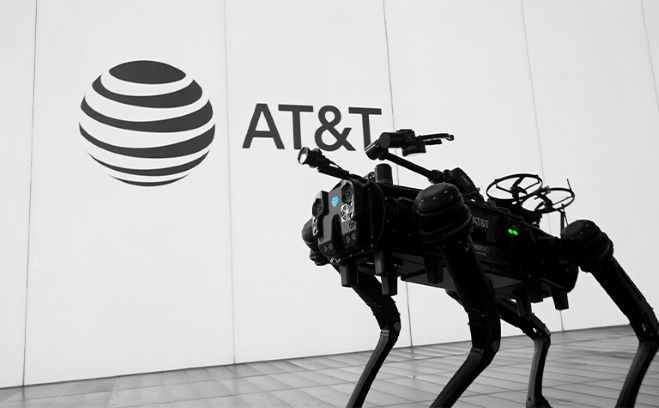Truly “Man’s Best Friend” for Public Safety and National Defense

By Lance Spencer, client executive vice president – Defense, AT&T
What has 4 legs, can recognize your face, and precisely obey commands on cue?
If you guessed a dog, you’re half right.
I’m referring to robotic dogs, a modern marvel of innovative engineering. We recently expanded our solution offers to include network-connected robotic dogs for public safety, defense, federal and state agencies, local police and fire departments, and commercial customers. We do this in collaboration with a leading provider of robotic dogs, Ghost Robotics.
Robotic dogs are just one way we are proving the innovation and transformational possibilities of 5G and IoT. Network-connected robotic dogs can deliver a broad range of IoT use cases, including many that have previously required putting personnel in dangerous situations. Here’s a quick look at some of the fantastic capabilities network-connected robotic dogs deliver.
- Our robotic dogs can support public safety agencies and organizations on FirstNet® – the nation’s only network built with and for America’s first responders. FirstNet delivers always-on prioritized network connectivity for these “first responder” robotic dogs, helping them stay connected during disaster response and recovery, facilities surveillance, and security operations. They can support search and rescue, venture into areas that could imperil human lives, and support the ability to reestablish local communications services following major infrastructure damage.
- We can integrate Geocast into the robotic dogs to provide Beyond-Visual-Line-of-Sight (BVLOS) operational command and control so that operators of the dogs can be located virtually anywhere in the world and remotely operate them. Geocast is an AT&T innovation covered by 37 patents.
- The robotic dogs can be equipped with sensors that allow them to operate autonomously without human intervention. They can be outfitted with drones that can launch and return to their backs while in motion, allowing the drones and dogs to perform missions as an integrated team.
- Rugged terrain? Water? Not a problem. These robotic dogs can move across natural terrain, including sand, rocks, hills, rubble, and human-built environments, like stairs. They can operate fully submerged in water and, like living dogs, can swim.
- An early use case adopted by the military involves equipping our robotic dogs with wireless network-connected cameras and deploying them to patrol military bases. Robotic dogs we provided to the Air Force at Tyndall Air Force Base in the Florida panhandle are doing just that. Our robotic dogs patrol the flight line and base perimeter at Tyndall, feeding video data in real-time to base personnel who can safely track activity 24/7/365 and support the safety of base operations. They can perform the same task for commercial users, indoors or outdoors. For example, they can patrol the perimeters of large warehouses or outdoor fence lines.
- They can also support hazmat efforts, inspect mines and high-voltage equipment, and detect explosive devices including improvised explosive devices (IEDs): all while keeping people out of harm’s way.
- Another interesting use case involves equipping robotic dogs with Long Range Acoustic Devices (LRADs). LRADs are sound cannons that produce noise at high decibels and varying frequencies. We have discussed with the Navy the possibility of outfitting our robotic dogs with sound cannons to warn off wild boars and feral dog packs that have impeded operating crews working on telecommunications infrastructure located in remote areas of one of its bases.
Commercial applications for network-connected robotic dogs are proliferating. Utility companies, for example, are using robotic dogs equipped with video cameras to perform routine equipment inspections in substations. Human inspection requires operators to shut down the facilities during inspections; the robotic dogs eliminate the need to take this precaution. Allied Market Research projects a $13.4B global market for the particular use case of robotic dogs performing such inspections.
Our robotic dogs can also be equipped with technology that extends network connectivity into difficult-to-reach areas or mechanical arms that can grip and carry materials such as tools. Their use cases include Pick and Pack capabilities for warehouse operations to improve order fulfillment efficiency.
And this is just the beginning. We’ve said from the outset that the 5G journey of innovation and solution development would evolve to deliver new ways to conquer many challenges.
Now, we’ve let the dogs out.
Check out the video below for a quick view of one of the robotic dogs in action: